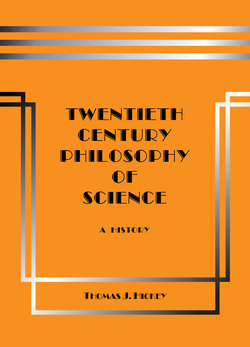Читать книгу Twentieth-Century Philosophy of Science: A History (Third Edition) - Thomas J. Hickey - Страница 53
На сайте Литреса книга снята с продажи.
3.22 Componential vs. Wholistic Semantics
ОглавлениеSemantical change had vexed the contemporary pragmatists, when they initially accepted the artifactual thesis of the semantics of language. When they rejected a priori analytic truth, many of them mistakenly also rejected analyticity altogether. And when they accepted the contextual determination of meaning, they mistakenly took an indefinitely large context as the elemental unit of language for consideration. They typically construed this elemental context as consisting of either an explicitly stated whole theory with no criteria for individuating theories, or an even more inclusive “paradigm”, i.e., a whole theory together with many associated pre-articulate skills and tacit beliefs. This wholistic (or “holistic”) semantical thesis is due to using the psychological experience of meaning instead of making semantic analyses that enable recognition of the componential nature of meaning.
On this wholistic view therefore a new theory that succeeds an alternative older one must, as Feyerabend maintains, completely replace the older theory including all its observational semantics and ontology, because its semantics is viewed as an indivisible unit. In his Patterns of Discovery Hanson attempted to explain such wholism in terms of Gestalt psychology. And following Hanson the historian of science Kuhn, who wrote a popular monograph titled Structure of Scientific Revolutions, explained the complete replacement of an old theory by a newer one as a “Gestalt switch”.
Feyerabend tenaciously maintained wholism, but attempted to explain it by his own interpretation of an ambiguity in Benjamin Lee Whorf’s thesis of linguistic relativity also known as the “Sapir-Whorf hypothesis” formulated jointly by Whorf and Edward Sapir, a Yale University Linguist. In his “Explanation, Reduction and Empiricism”, in Minnesota Studies in the Philosophy of Science and later in his Against Method Feyerabend proposes semantic “incommensurability”, which he says is evident when an alternative theory is not recognized to be an alternative. He cites the transition from Newtonian to Einstein’s relativity physics as an example of such incommensurability. The thesis of semantic incommensurability was also advocated by Kuhn, but he later revised the idea to admit partial or local incommensurability that enables “incommensurability with comparability”, but without successfully explaining how it can be partial.
Any wholistic semantical thesis including notably the semantic incommensurability thesis creates a pseudo problem for the decidability of empirical testing in science. It implies complete replacement of the semantics of the descriptive terms used for test design and observation. And complete replacement deprives the two alternative theories of any semantical continuity, such that their language cannot even describe the same phenomena or address the same problem. In fact the new theory cannot even be said to be an alternative to the old one, much less a more empirically adequate one. The empirical undecidability due to alleged semantical wholism would logically deny science both production of progress and recognition of its history of advancement. The untenable character of the situation is comparable to the French entomologist August Magnan whose book titled Insect Flight (1934) set forth an aerodynamic analysis proving that bees cannot fly. Bees do fly, and empirical tests do decide.
The thesis of componential semantics resolves the wholistic semantical muddle in the linguistic theses proffered by philosophers such as Kuhn and Feyerabend. Philosophers of science have overlooked componential semantics, but linguists have long recognized componential analysis in semantics, as may be found for example in George L. Dillon’s Introduction to Contemporary Linguistic Semantics. Some linguists use the phrase “lexical decomposition”. With the componential semantical thesis it is unnecessary to accept any wholistic view of semantics in philosophy much less any incommensurable discontinuity in language.
The expression of the componential aspect of semantics most familiar to philosophers of language is the analytic statement. But the pragmatists’ rejection of the analytic-synthetic dichotomy with its a priori truth claim need not imply the rejection of analyticity as such. The contextual determination of meaning exploits the analytic-empirical dualism.
Therefore when there is a semantical change in the descriptive terms in a system of beliefs due to a revision of some of the beliefs, some component parts of the terms’ complex meanings remain unaffected, while other parts are dropped and new ones added. For empirical testing in science the component meaning parts that remain unaffected by the change from one theory to a later alternative one include those parts determined by the statements of test design shared by the two theories, even if the executable test design was formulated after the older theory was initially proposed. Therein is found the semantical continuity that enables empirical testing of alternative theories to be decidable.
Thus a revolutionary change in scientific theory, such as the replacement of Newton’s theory of gravitation with Einstein’s, has the effect of changing only part of the semantics of the terms common to both the old and new theories. It leaves the semantics supplied by test-design language unaffected, so Arthur Eddington could test both Newton’s and Einstein’s theories of gravitation simultaneously by describing the same celestial photographic observations in his 1919-eclipse test. Thus contrary to Feyerabend there is no semantic incommensurability between these theories. And contrary to Feyerabend there is there no historical evidence that the advocates of Einstein’s relativity theory had failed to recognize that Einstein’s theory is an alternative to Newton’s.
Readers wishing to know more about the philosophies of Kuhn, Feyerabend, and Eddington’s 1919-eclipse test are referred to BOOK VI below.
